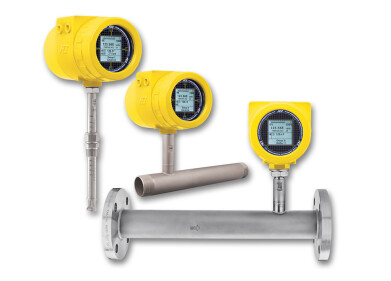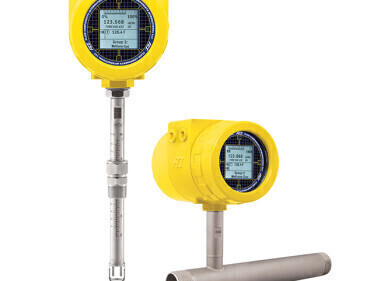Flow level pressure
WirelessHART Products Monitor Flow on Norweigan
Sep 14 2009
Using open WirelessHART™ products, Emerson Process Management’s Smart Wireless network is automating flow monitoring to increase production on the company’s Gullfaks offshore platforms in the northern part of the Norwegian North Sea. Needing a monitoring approach able to be installed without interrupting flow, operators are using wireless devices to transmit real time temperature data that indirectly monitors flow, allowing quick reaction to any loss of well pressure and maximising throughput from the well. This installation follows the success of Smart Wireless on StatoilHydro’s Grane platform.
StatoilHydro, the leading oil and gas operator on the Norwegian continental shelf, was occasionally losing flow from the producing wells at its Gullfaks A, B and C platforms, caused by a loss of wellhead pressure. Early detection of the loss of flow is important as this enables operators to flow the well through the test separator and thus re-establish flow by reducing pressure. Bringing flow back quickly improves throughput and over time significantly increases production.
The loss of flow was very difficult to detect due to there being no existing flow-metering devices installed within the well pipes. Installing such devices for this application was not practical as this would require a complete shut down of production, which would be far too expensive in terms of lost throughput. A non intrusive solution was required, but the introduction of new sensors brings with it the problem of connecting them back to the control room. The wellhead was already a very crowded area and for safety reasons it must be kept as clear as possible. The introduction of additional equipment such as new cabling, cable trays and junction boxes was not possible.
In the past, StatoilHydro detected loss of flow by sending an operator to the wellhead where they placed their hand on the pipe to feel whether there was a difference between the pipe temperature and the ambient temperature. Typically well fluid is 60° C so the pipe feels warm, but should flow be interrupted it slowly drops back to the ambient temperature. Temperature readings were taken only at the start and the end of a shift, so a loss of flow could easily go undetected for long periods and production would be lost.
Needing to automate the monitoring so as to provide real-time data, while also reducing personnel presence in hazardous areas, StatoilHydro initially implemented a pilot installation on the Gullfaks A, B & C platforms. Emerson’s Rosemount® 648 wireless temperature transmitters were installed to indirectly indicate flow on lines at each of forty wells. The wireless devices are used to transmit data from clamp-on temperature sensors mounted on the surface of the flow pipes.
“Installing additional wired measurement points at the wellhead would mean long cable trays and a lot of wiring,” said Anders Røyrøy, Project Manager, Research & Development Projects, StatoilHydro Norway. “Wireless offers an inherent reduction in cabling infrastructure, complexity and weight, resulting in significantly lower installation costs. “ “Because there is daily radio communication within the well area it is essential that the wireless field network can coexist without any reduction in performance,” continued Anders Røyrøy. “We have found that Emerson’s Smart Wireless mitigates the impact of interference and the data reliability is 100%.”
In contrast with the once-a-shift manual recordings, Emerson’s wireless devices now transmit readings every 30 seconds back to the Smart Wireless Gateway. The gateway is hardwired straight into the existing control system providing operators with the real time information they need to react quickly to any change in flow.
”Emerson’s wireless transmitters have enabled the quick and reliable detection of lost flow, and the immediate action to re-establish flow has increased production significantly.” said Tormod Jenssen, Staff Engineer, Plant Integrity, Gullfaks field. “Emerson’s wireless devices are installed very quickly,” said Anders Røyrøy. ”Typically each device takes only a matter of hours to install compared to up to two days for a conventional wired device.”
StatoilHydro has now implemented additional Smart Wireless devices on Platforms A, B and C, bringing the total to 90 wireless transmitters covering all production flow lines at
Gullfaks. “Rich process information and plant diagnostics are essential for unmanned operation and by introducing Smart Wireless transmitters to our platforms we are making broad
strides towards our aims,” said Anders Røyrøy.
Digital Edition
PIN 25.5 Oct/Nov 2024
November 2024
Analytical Instrumentation - Picturing Viscosity – How Can a Viscometer or a Rheometer Benefit You? - Sustainable Grease Formulations: Evaluating Key Performance Parameters and Testing Method...
View all digital editions
Events
Jan 20 2025 San Diego, CA, USA
Jan 22 2025 Tokyo, Japan
Jan 25 2025 San Diego, CA, USA
SPE Hydraulic Fracturing Technology Conference and Exhibition
Feb 04 2025 The Woodlands, TX, USA
Feb 05 2025 Guangzhou, China



















